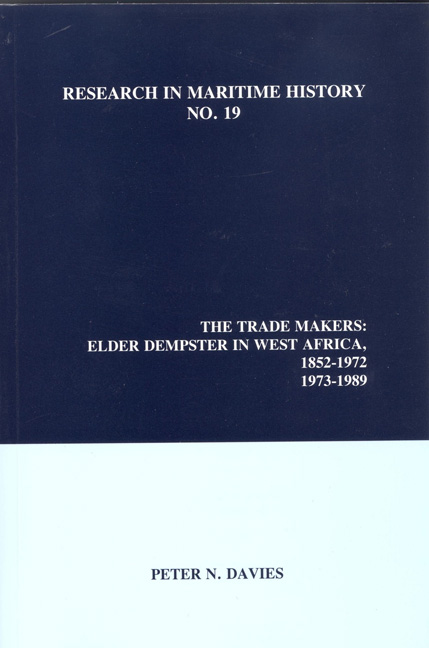Book contents
- Frontmatter
- Table of Contents
- List of Illustrations
- Foreword
- Introduction (Second Edition)
- Foreword
- Preface
- Acknowledgments
- Introduction to the Original Edition
- Frontispiece
- Part One The Pioneers
- Part Two Elder Dempster And Company
- Part Three Elder Dempster And Company Limited
- Part Four Elder Demster Lines Limited
- Part Five The End Of An Era
- List of Appendices
- Appendices
- Bibliography
- Index
Introduction to the Original Edition
- Frontmatter
- Table of Contents
- List of Illustrations
- Foreword
- Introduction (Second Edition)
- Foreword
- Preface
- Acknowledgments
- Introduction to the Original Edition
- Frontispiece
- Part One The Pioneers
- Part Two Elder Dempster And Company
- Part Three Elder Dempster And Company Limited
- Part Four Elder Demster Lines Limited
- Part Five The End Of An Era
- List of Appendices
- Appendices
- Bibliography
- Index
Summary
The coastline of West Africa lies between Cape Verde and Mount Cameroon. This is a distance of approximately 2400 miles, but it only contains two good natural harbours - those at Dakar and Freetown. Both of these are situated in the extreme west of the region, while the remainder of the seaboard provides few satisfactory port sites because of the presence of esturine bars, heavy surf, shallow lagoons, marshes or mangrove swamps. The land behind the coast consists mainly of tropical rain forests or savannah and these diverse areas have naturally developed two different cultures. The inhabitants of the forest lands near the coast, where the climate is hot and moist, have tended to live in small, inward-looking communities, with a subsistence economy based on a limited technology; whereas those who lived in the hot, dry climate of the savannah have more commonly joined together in larger societies which have enjoyed a more advanced economy and technology. Moreover, the existence of a coastal forest belt to the south, allied with the activities in the forest of the tsetse fly, has meant that the savannah areas of the interior were virtually isolated from the western seaboard. In these circumstances the trade that was undertaken tended to be relatively small and came overland from either the north or east of Africa.
Europe first came into contact with West Africa as a result of the voyages organised by Prince Henry of Portugal in the middle of the fifteenth century. The prime objective of these explorations was to find a new route to India but a small trade slowly evolved along the West African coastline. This activity assumed a new significance with the discovery of the Gold Coast and in 1482 a fort was established on the site of what is now Elmina. Gold, ivory, pepper, civet, palm oil, palm mats, ambergris, wax, hides, skins, cotton, rice, wooden bowls and millet were then exported in increasing quantities in exchange for imports of cloth, brass bracelets, corals, wine, shells and beads. Profits from these transactions proved to be extremely high, but the heavy mortality from tropical diseases tended to inhibit the growth of the trade.
- Type
- Chapter
- Information
- The Trade MakersElder Dempster in West Africa, pp. xxvi - xxxviiPublisher: Liverpool University PressPrint publication year: 2000

